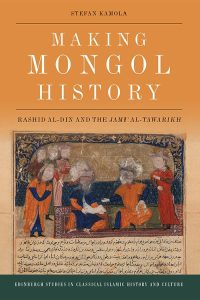
By Stefan Kamola, author of Making Mongol History: Rashid al-Din and the Jamiʿ al-Tawarikh
Early in 1839, Professor of Linguistics Duncan Forbes arrived in Inverness with Mir Afzal Ali, representative of the Maharaja of Satara. They had come to visit the estate of the late Colonel John Baillie to examine the Persian and Arabic manuscripts that Baillie had collected during his term as Resident at Lucknow for the British East India Company between 1807 and 1815. Among the manuscripts was a large-format but incomplete book with stunning illustrations of the Prophet Muhammad and of later Islamic dynasties. Mir Afzal Ali alerted Forbes that this book was a fragment of the Jamiʿ al-Tawarikh (Collection of Histories), a history of the world prepared by Rashid al-Din (d. 1318) for the Mongol lords who ruled the Middle East in the early 14th century.
In 1839, Rashid al-Din’s history had newly caught the attention of European orientalists: in 1833, the French scholar Étienne de Quatremère had published for the first time part of Rashid al-Din’s history of the Mongols, and as recently as 1838, the 23 year old barrister William Hook Morley had discovered another illustrated fragment of Rashid al-Din’s world history among the manuscripts of the Royal Asiatic Society (RAS). That fragment included Rashid al-Din’s history of India, which Morley began studying in minute detail, part of a broader British effort to gather historical information about their Indian colony. Mir Afzal Ali must have seen the RAS fragment, for he was able to identify the Inverness fragment as part of the same book. Forbes alerted the leadership of the Royal Asiatic Society to this discovery, and the Society’s Assistant Secretary, Edwin Norris, scrawled out a letter to Morley on 24 April 1839, announcing the discovery as:
“A wonder!! The remainder of the fragment of Rashid eddin has been found!!! It is among the late Col. Baillie’s m.s. and is entitled “Tarikhi Tabari.” Professor Forbes of King’s College has examined it, and found that it is not Tarikhi Tabari but Rashid eddin, and, what is more curious, that it is the portion of the volume of which we have a fragment; and, what is most curious, that it is a portion of the same book, the same identical, physical, bodily book; that in fact the two fragments once formed one complete volume, but that some rascal with ‘fatal scissors’ has severed them, but not ‘for ever and ever’ we will hope.”
London BL ms. IO Islamic 3628 fol. 354a.
Rashid al-Din was more than 500 years dead, but Norris’s letter ushered in a modern fascination with his life and work. He was a convert to Islam, having been born Jewish between waves of Mongol invasion in the Middle East. Over time, he rose to the highest ranks in a civil administration created to help the Mongols govern the region after they killed off the last of the ʿAbbasid caliphs. As vizier, he served two brothers who ruled in turn: Ghazan Khan from 1295 to 1304 and then Oljeitu until 1316. During those two decades, Rashid al-Din produced a series of major projects that proclaimed his patrons’ power and legitimacy. His history was just the first part of these efforts: he also wrote treatises presenting Oljeitu as a supreme theological authority in the mold of a shiʿi imam, and he commissioned major building projects that showed his Mongol lords and himself to be great patrons of the arts, of charity, and of scholarship. In his day, he was the chief propagandist for a regime of foreign occupation. Since the 1830s, he has been hailed as a leading source on the history of that regime.
Making Mongol History traces the life and work of Rashid al-Din, focusing on his most famous historical writings, but showing also how his theological works and his building programs fed into a larger life project to promote the interests of his Mongol patrons. In some respects, this book is a biography, but there is much about Rashid al-Din’s life that makes it impossible to confidently reconstruct. Instead, this book focuses on the circumstances and consequences of the life. The period of the Mongol conquest was a unique time of social, political, and intellectual foment in the Middle East. Among the destruction of the early conquests, new ideas about religion and the state began to develop. Rashid al-Din helped develop these new ideas, and his work in turn helped to shape later states across southwest Asia.
While the life story of Rashid al-Din has been told before, Making Mongol History explores the afterlife of his historical writing through its surviving manuscript copies. As a result of modern imperial activity like that of the British East India Company, most of these manuscripts are now found the great 19th-century capitals of London, Paris, Istanbul, and St. Petersburg. While a few of the more spectacular examples have been extensively studied, such as the two-fragment copy that captured the British imagination in the 1830s, many more have sat largely neglected for decades or centuries. In preparing this book, I examined most of these manuscripts in person, piecing together from them the fascinating life of Rashid al-Din’s history, both during his lifetime and in the 7 centuries that have passed since his death. Norris’s breathless letter to Morley is bound in the back of one of these long-neglected manuscripts. It is just one example of the stories found between the covers of these unique historical witnesses to the life of the Jamiʿ al-Tawarikh.
Making Mongol History: Rashid al-Din and the Jamiʿ al-Tawarikh by Stefan Kamola is available now in the Edinburgh Studies in Classical Islamic History and Culture series. Visit the Edinburgh University Press website to find out more

Stefan Kamola is Assistant Professor of History at Eastern Connecticut State University. He received a Ph.D. in History from the University of Washington in 2013 and then spent three years as a post-doctoral fellow at the Princeton Society of Fellows. Stefan has published an article in the Journal of the Royal Asiatic Society and a chapter in Sussan Babaie, ed., Iran After the Mongols. The Idea of Iran, Volume VIII (I.B. Tauris, 2019).






